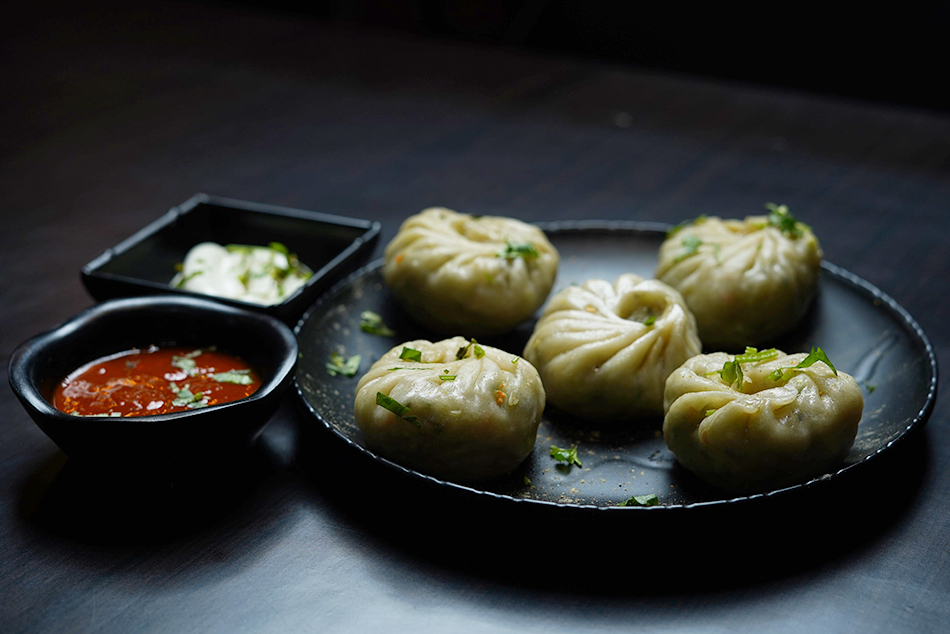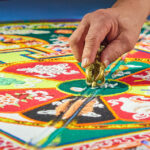Embarking on a journey to the awe-inspiring land of Tibet promises not only breathtaking landscapes and ancient monasteries but also a culinary adventure that will tantalize your taste buds. The rich tapestry of Tibetan food culture, influenced by the challenging environment of the Qinghai-Tibet plateau and the profound teachings of Tibetan Buddhism, introduces travelers to a unique array of flavors and traditions. Let’s explore the must-try Tibetan foods that will undoubtedly enhance your experience in the mystical city of Lhasa.
1. Tsampa: A Symbolic Culinary Tradition
The first Tibetan Food You Must Try In Tibet is Tsampa. Tsampa crafted from highland barley, stands as the heart of Tibetan cuisine, transcending mere sustenance to become a cultural icon. During festivals like Losar, Tibetans toss Tsampa flour into the air, symbolizing prayers for peace and prosperity. Beyond its ceremonial role, Tsampa is a vital source of nutrition for survival on the challenging Qinghai-Tibet Plateau.
Enjoyed alongside salty Tibetan butter tea, Tsampa offers a perfect balance of protein, fat, and carbohydrates. This unique blend not only satisfies the palate but also reflects the deep connection between Tibetan people, their environment, and culinary traditions. The tactile experience of kneading Tsampa in butter tea highlights the intimate bond between Tibetans and their culinary heritage, making it a must-try, not just for its flavors, but for the cultural story it encapsulates. In each bite, you taste the resilience, spirituality, and communal strength of Tibet.
2. Tibetan Yak Meat: A Culinary Masterpiece
The Second Tibetan Food You Must Try In Tibet is Tibetan Yak Meat. Tibetan yaks, resilient inhabitants of the plateau, lend their unique essence to Tibetan cuisine, creating a culinary masterpiece. The chewy and nutritious yak meat, seasoned with natural spices and air-dried, stands as a distinctive hallmark.
This culinary trademark not only showcases the nomadic lifestyle but also emphasizes the deep connection between nature and Tibetan culture. The harmonious relationship between yaks and Tibetan nomads goes beyond sustenance; it shapes a culinary tradition that mirrors the symbiotic coexistence in the harsh plateau environment. Each bite of yak meat tells a story of resilience, sustainability, and the intricate dance between the plateau’s denizens and their flavorful offerings. As you savor the chewiness and delicate flavors, you partake in a culinary journey that captures the very spirit of Tibetan life.
3. Tibetan Momo: Culinary Fusion in Dumpling Form
The Third Tibetan Food You Must Try In Tibet is Tibetan Momo. Tibetan momos, a delightful twist on traditional dumplings, showcase a fusion of Tibetan and neighboring culinary influences. Available in various shapes and filled with yak meat or vegetarian ingredients, momos offer a savory journey through Tibetan flavors.
Whether steamed, fried, or in a comforting soup, each bite reflects the rich tapestry of influences that have shaped Tibetan cuisine. The tender texture and flavorful fillings encapsulate the seamless blend of tradition and innovation. As you savor the diversity of momos, you’re not just tasting dumplings; you’re experiencing the cultural crossroads where Tibetan culinary heritage meets the influence of neighboring traditions. This culinary experience is a testament to the openness and adaptability of Tibetan cuisine, inviting you to indulge in the creative and delicious world of Tibetan momos.
4. Tibetan Noodle Soup (Thukpa): A Tea House Comfort
Embark on a culinary journey at Lhasa’s bustling tea houses with Tibetan noodle soup, a quintessential dish after exploring sacred monasteries. Crafted with handcrafted noodles, flavorful bone broth, shredded yak meat, and vegetables, this dish offers a comforting and hearty meal.
Served piping hot, Tibetan thukpa provides solace to weary pilgrims and curious travelers alike. The blend of textures and flavors in each spoonful embodies the essence of Tibetan hospitality and culinary warmth. As you savor the goodness of the handcrafted noodles and the nourishing broth, you not only taste a tea house classic but also partake in a cherished tradition that has comforted souls for generations in the heart of Lhasa. Thukpa is more than a soup; it’s a bowl of hospitality, culture, and the heartwarming embrace of Tibetan culinary craftsmanship.
5. Tibetan Yogurt: Timeless Creaminess
Indulge in the creamy delight of Tibetan yogurt, a cherished favorite sold on streets and in restaurants across Tibet. Crafted from Tibetan yak milk, this luscious yogurt, free from harmful additives, encapsulates a taste of tradition that spans a thousand years.
With a texture that’s both velvety and rich, Tibetan yogurt stands as a testament to the enduring culinary practices of the region. Whether enjoyed plain or adorned with toppings, each spoonful carries the essence of a time-honored tradition. The fermentation process, using pure Tibetan yak milk, adds a unique tang, making every bite a journey through centuries of flavor evolution. As you relish this timeless creamy treat, you’re not just savoring yogurt; you’re experiencing a living tradition that has stood the test of time in the heart of Tibet.
6. Dre-si: A Sweet Symbol of Prosperity
Delight in the unique Tibetan dessert, Dre-si, a confection often relished during Tibetan New Year festivities. Crafted from nutritious Droma root, butter, broth, and sugar, Dre-si transcends its status as a dessert; it symbolizes a wish for good luck and prosperity.
As you savor each bite, you’re not merely enjoying a sweet treat but participating in a tradition that carries a deeper cultural resonance. The careful blend of ingredients in Dre-si mirrors the hope for a bountiful and prosperous year ahead. Whether served at festive gatherings or placed before Buddhist shrines for blessings, Dre-si serves as a sweet omen, inviting you to partake in the optimism and cultural richness woven into this delectable Tibetan dessert. Indulge in Dre-si, and let its flavors carry you into a world where sweetness extends beyond the palate—into the realm of tradition and aspirations for a brighter future.
7. Tibetan Butter Tea: Soulful Nourishment
Embrace the cherished Tibetan tradition of sipping Tibetan butter tea while enjoying Tsampa. More than a beverage, this essential elixir serves as soulful nourishment, shielding Tibetans from the challenges of hunger and exposure. A rich blend of tea leaves, yak butter, water, and salt, Tibetan butter tea, known as “po cha,” encapsulates the resilience and resourcefulness of the Tibetan people.
The preparation involves a ceremonial churn, blending the robust tea leaves with the creamy yak butter, creating a concoction that not only warms the body but also revitalizes the spirit. Each sip is a journey into the heart of Tibetan hospitality, where the sharing of butter tea fosters camaraderie and offers respite in the demanding high-altitude environment. As you partake in this time-honored tradition, you’re not just drinking tea; you’re immersing yourself in a ritual that sustains both body and soul in the breathtaking landscapes of Tibet.
8. Tibetan Sweet Tea: A Sip of Sugary Bliss
For those seeking a sweet alternative, Tibetan sweet tea beckons as a delightful choice. A popular selection in tea houses, this sugary bliss, crafted with powdered milk, black tea, and sugar, becomes the perfect companion for leisurely moments shared among friends.
As the aromatic black tea blends with the creamy richness of powdered milk, and the sweetness of sugar, each sip offers a taste of comfort and camaraderie. Tibetan sweet tea serves as a respite for those who prefer a sweeter note, creating an inviting atmosphere in the vibrant tea houses across Tibet. Whether enjoyed alone as a moment of personal indulgence or shared among friends, this beverage exemplifies the versatility and warmth that Tibetan tea culture brings to social gatherings. Revel in the sweet simplicity of Tibetan sweet tea and let its sugary bliss add a touch of delight to your culinary exploration in the heart of Tibet.
9. Lhasa Beer:
Elevate your spirits with a glass of Lhasa beer, a libation celebrated as the beer from the roof of the world. Crafted with precision, this brew boasts a symphony of Himalayan spring water, highland barley, saaz hops, and yeast, delivering an unparalleled quality and taste that has become a favorite among international tourists.
As you raise your glass, you partake in a toast to the majestic landscapes that surround Lhasa, sipping on the essence of the region’s natural bounty. The superb quality and unique flavor profile of Lhasa beer make it not just a beverage but an experience—an embodiment of the spirit of the highest peaks. Capture a moment in time as you savor this regional brew, letting the effervescence of Lhasa beer transport you to the roof of the world, where every sip is a celebration of the extraordinary brewing traditions rooted in the heart of Tibet.
10. Chang (Barley Wine):
Embark on a journey through tradition with Chang, the revered barley wine and a quintessential toast in Tibetan culture. As the traditional alcoholic beverage of Tibet, Chang, crafted with highland barley, millet, and rice grains, takes center stage during festivals, weddings, and special occasions.
In every sip, you taste the heritage and craftsmanship passed down through generations, making Chang more than a beverage—it’s a living testament to the celebratory spirit of Tibetan life. The mingling of highland barley, millet, and rice grains creates a harmony of flavors that has stood the test of time. Whether shared in joyous festivities or solemn ceremonies, Chang encapsulates the essence of Tibetan hospitality and tradition. Indulge in this barley wine, and let each drop be a tribute to the enduring legacy of Tibetan libations, uniting communities in moments of joy and reverence.
Conclusion Of Tibetan Food You Must Try In Tibet
As you can see, there are many Tibetan foods to try while you’re visiting. Even if you only have a few chances to try the food in restaurants, you’ll now know what to look out for to have an authentic experience.
Have you traveled to Tibet? Had any of these Tibetan foods you must try in Lhasa? Tell us about it in the comments section.














